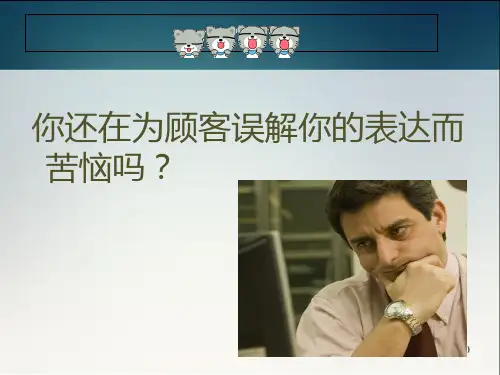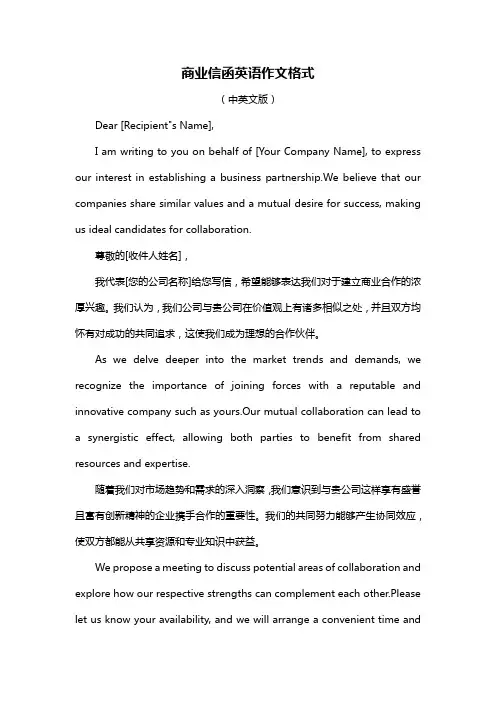精编商务英语___信件写作格式.ppt
- 格式:ppt
- 大小:1.54 MB
- 文档页数:22







商业信函英语作文格式(中英文版)Dear [Recipient"s Name],I am writing to you on behalf of [Your Company Name], to express our interest in establishing a business partnership.We believe that our companies share similar values and a mutual desire for success, making us ideal candidates for collaboration.尊敬的[收件人姓名],我代表[您的公司名称]给您写信,希望能够表达我们对于建立商业合作的浓厚兴趣。
我们认为,我们公司与贵公司在价值观上有诸多相似之处,并且双方均怀有对成功的共同追求,这使我们成为理想的合作伙伴。
As we delve deeper into the market trends and demands, we recognize the importance of joining forces with a reputable and innovative company such as yours.Our mutual collaboration can lead to a synergistic effect, allowing both parties to benefit from shared resources and expertise.随着我们对市场趋势和需求的深入洞察,我们意识到与贵公司这样享有盛誉且富有创新精神的企业携手合作的重要性。
我们的共同努力能够产生协同效应,使双方都能从共享资源和专业知识中获益。
We propose a meeting to discuss potential areas of collaboration and explore how our respective strengths can complement each other.Please let us know your availability, and we will arrange a convenient time andlocation for the meeting.我们提议召开一次会议,讨论可能的合作领域,并探讨我们各自的优势如何相互补充。



商务英语信函格式英文信件格式商务英语信函格式英文信件格式通常情况下,公司都会专门印制带有信头的信笺纸,包括发信人的姓名,地址,电话,传真等。
当我们撰写传统信件时,直接使用这种信笺纸就可以。
2、编号(写信人的名字缩写)和日期The sender name and the date这部分内容是为了方便今后查询信件用的。
3、封内地址The inside address这里就是指收信人的姓名和地址,一般写在信笺的左上方。
收信人名称地址的格式和信头的格式相同,但必须把收信人的姓名一并写出。
另外,如果不是完全公事化的书信往来,或者已经从公事的关系渐渐发展成为带有私人性质的友好信件往来,由于称呼这一栏的内容已经说明了收信人的身份,所以可以不必填写封内地址。
4、事由The subject heading事由也就是我们通常说的主题,可以直接写明信件的重点,让人不必读完全信才了解到信的内容。
所以事由要写得简明扼要。
5、称呼The salutation指对收信人的一种称呼。
较常使用的有Dear Sirs, Dear Madam, Dear Mr. XX,。
称呼后面的标点,一般使用逗号。
称呼里的第一个字母要大写。
6、开头语The open sentences开头语没有统一的格式,但习惯上先用客套的语句把收到对方来信的日期,主题及简单内容加以综合叙述,使对方一目了然这是答复哪一封去信的。
如果是第一次通信,也可以利用开头语作必要的,并表明目的要求。
开头语一般与正文分开,自成一节,要求简单明了。
7、正文The body of the letter信的主体。
一封信件的优劣,完全要看正文写的好或坏。
我们会在后面继续讨论写作商务信函的一些技巧、规则。
8、结尾语The complimentary close结尾语一般用来总结文本所谈的事项,提示对收信人的要求,如希望来信来函定货,答复询问等,另外也附加一些略带客套的语气。
正文结束后,另起一段写结尾语。

商务英语写作信函标准格式Business letters are a crucial form of communication in the professional world. They serve as a formal means of conveying information, requests, or proposals between individuals, organizations, or businesses. Adhering to a standardized format for business English letter writing is essential to ensure clarity, professionalism, and effective communication.The standard format for business English letter writing typically consists of several key elements. The first element is the letterhead, which includes the company's name, address, and contact information. This information should be prominently displayed at the top of the letter, often centered or aligned to the right. The letterhead serves to establish the sender's identity and provide the recipient with the necessary contact details.Following the letterhead, the next element is the date. The date should be written in a formal format, such as Month Day, Year (e.g., June 15, 2023). This information is typically aligned to the right and provides a clear record of when the letter was written.The third element is the recipient's information, which includes their name, title, and address. This information should be aligned to the left and should be formatted in a clear and concise manner. It is important to ensure that the recipient's information is accurate to avoid any potential confusion or miscommunication.The salutation is the next element in the standard format for business English letter writing. The salutation should be appropriate for the recipient and the context of the letter. Common salutations include "Dear Mr./Ms. [Recipient's Last Name]," or "Dear [Recipient's Title] [Recipient's Last Name]." The salutation should be followed by a colon.The body of the letter is the next and most substantial element. The body should be organized into paragraphs that clearly convey the purpose of the letter. Each paragraph should focus on a specific topic or idea and should be written in a clear, concise, and professional manner. The tone of the letter should be appropriate for the context and the recipient, ranging from formal to conversational, depending on the situation.The closing of the letter is the penultimate element. The closing should be a polite and respectful phrase, such as "Sincerely," "Best regards," or "Yours truly." The closing should be aligned to the rightand should be followed by a comma.The final element is the signature block, which includes the sender's name, title, and contact information. This information should be aligned to the right and should be formatted in a clear and consistent manner.In addition to the standard format, there are several other important considerations when writing business English letters. For example, the language used should be formal and professional, avoiding the use of slang or overly casual expressions. Additionally, the letter should be free of spelling and grammatical errors, as these can reflect poorly on the sender and the organization they represent.Another important consideration is the layout and formatting of the letter. The letter should be visually appealing and easy to read, with appropriate spacing between paragraphs and consistent alignment of the various elements. The use of headings, bullet points, or other formatting techniques can also help to improve the clarity and organization of the letter.Finally, it is important to consider the purpose and tone of the letter. Business letters can serve a variety of purposes, such as requesting information, making a proposal, or responding to a complaint. The tone of the letter should be appropriate for the purpose and therecipient, ranging from formal and professional to more conversational and friendly, depending on the context.In conclusion, the standard format for business English letter writing is an essential tool for effective communication in the professional world. By adhering to this format and considering the various other important factors, individuals and organizations can ensure that their business letters are clear, professional, and effective in achieving their desired outcomes.。